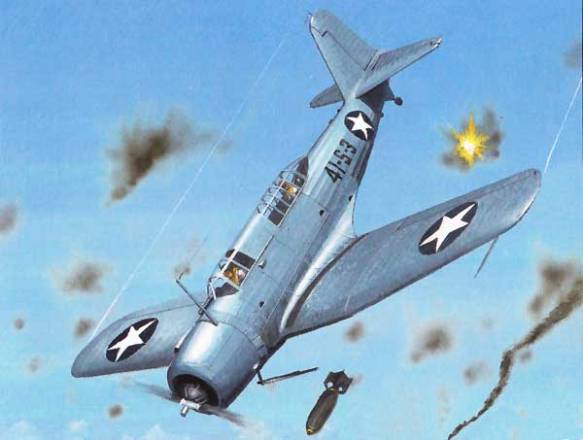The Vindicator was the Navy’s first monoplane scout-bomber. Fast and modern for its day, it was obsolete by World War II and quickly removed from service.
By 1934 the Chance Vought Corporation was designing a replacement for its SBU scout-bomber. It emerged as the XSB2U, a radical departure from the biplanes then in use. The new craft was a low-wing monoplane with retractable landing gear and folding wings for ease of storage onboard carriers. However, like the biplanes it was intended to replace, the XSB2U was partially constructed of metal and partly covered in fabric. The prototype first flew in 1936, by which time the Navy contracted to acquire 54 machines. This was followed by orders for 58 SB2U2s in 1938 and 57 SB2U3s in 1940. The latest model was the first to be officially called the Vindicator, and it equipped four squadrons aboard the carriers Lexington, Saratoga, Wasp, and Ranger. An export model, V156, was also purchased by France in anticipation of World War II.
The Vindicator’s combat career was short but violent. Vindicators equipped two squadrons of the French Aeronautique Maritime and fought well until France was overrun by Germany in May 1940. Great Britain also ordered 50 V156s, christened Chesapeakes, which were found too bulky for small British carriers and assigned to training duty. However, after the Japanese attack on Pearl Harbor in December 1941, the aging SB2Us were necessarily pressed into frontline service. In spring 1942 they fought alongside Douglas SBDs and TBDs in various raids along the Caroline and Marshall Islands. However, their greatest test came in June 1942 during the decisive Battle of Midway, where they took heavy losses at the hands of Japanese Zero fighters. All SB2Us were quickly phased out of active duty in favor of more modern machines.
Variants
XSB2U-1
Single prototype, powered by a 750hp R-1535-78 engine.
SB2U-1
Initial production version powered by an 825hp R-1535-96 engine, 54 built.
SB2U-2
Same as SB2U-1 but with minor equipment changed, 58 built.
XSB2U-3
Single prototype of the extended-range version with twin floats, converted from the SB2U-1.
SB2U-3
Similar to the SB2U-2 but fitted with an 825hp R-1535-102 engine, crew armour and two 0.5in guns, 57 built
V-156F-3
Export version for the French Navy, 40 built.
V-156B-1
Export version similar to the SB2U-3 and powered by a 750hp R-1535-SB4-G engine for the British Royal Navy. Designated Chesapeake Mk.I; 50 built.
V-167
The V-156 company demonstrator was fitted with a more powerful Pratt & Whitney R-1830 engine and redesignated V-167. It remained a one-off.
Specifications (SB2U-2)
General characteristics
Crew: Two, pilot and gunner
Length: 34 ft 0 in (10.36 m)
Wingspan: 42 ft in (12.80 m)
Height: 10 ft 3 in (3.12 m)
Wing area: 305 ft² (28 m²)
Empty weight: 4,713 lb (2,138 kg)
Loaded weight: 6,379 lb (2,893 kg)
Max. takeoff weight: 7,332 lb (3,326 kg)
Powerplant: 1 × Pratt & Whitney R-1535-96 Twin Wasp Jr radial engine, 825 hp (616 kW)
Performance
Maximum speed: 251 mph (404 km/h)
Range: 630 mi (1,014 km)
Service ceiling: 27,500 ft (8,382 m)
Rate of climb: 1,340 ft/min (6.8 m/s)
Wing loading: 21 lb/ft² (103 kg/m²)
Power/mass: 0.13 hp/lb (0.21 kW/kg)
Armament
Guns:
1 × forward firing 0.30 in (7.62 mm) M1919 Browning machine gun in starboard wing (0.50 in (12.7 mm) M2 Browning machine gun in SB2U-3)
1 × .30 in (7.62 mm) machine gun in flexible mount for tail gunner (.50 in (12.7 mm) in SB2U-3)
Bombs: 1 × 1,000 lb (454 kg) or 500 lb (227 kg) bomb
